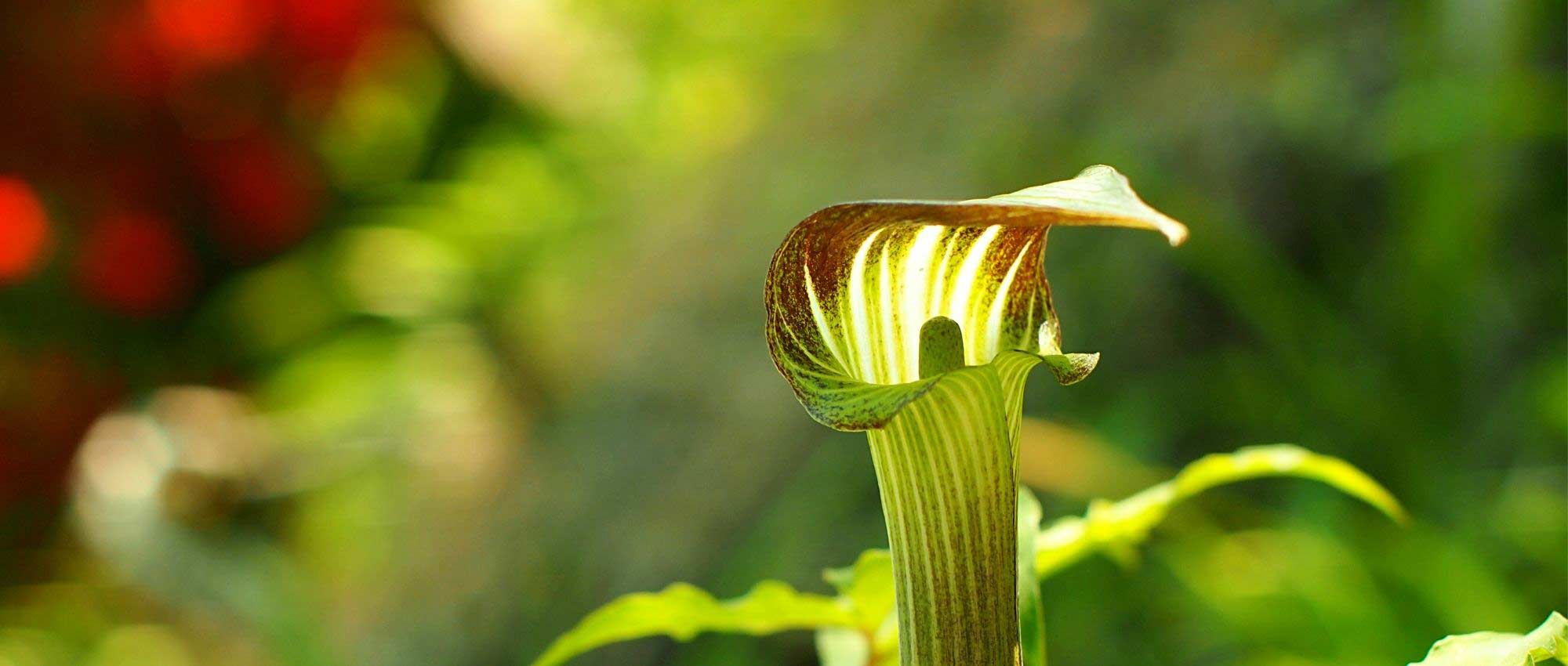
Arisaema: planting, growing, and care
Contents
Arisaema in a nutshell
- With its unusual flowering, Arisaema is a true botanical curiosity!
- It surprises with its flowering that resembles a cobra!
- Its large leaves, often palmate, have a very exotic style!
- It requires cool, light soil but fears stagnant moisture.
- It is ideal in woodland areas, alongside ferns and hostas.
A word from our Expert
Arisaema is an unconventional plant that piques curiosity. It is rarely seen in gardens. The flowering, which takes on a funnel shape, resembles a snake’s head : hence its nickname, Cobra Plant (cobra lily). The spathes are generally striate and come in shades of green, black, purple, or pink. Depending on the variety, Arisaema flowers in spring or summer. There is something almost animal-like about Arisaema: its flowering evokes a snake or an unknown creature… The spadix resembles a tongue emerging from a mysterious pink or purple throat. The stem itself is often maculate with purple spots, akin to the scaly skin of a snake or dragon. It also boasts beautiful foliage, with leaves composed of at least three leaflets, sometimes many more.
Arisaema are primarily understorey plants: they are therefore grown in shaded conditions, protected from direct sunlight. They find their place in a very natural-style garden, alongside ferns, hostas, and Geranium nodosum… contributing to an exotic atmosphere. This plant is somewhat delicate to grow, suited more for experienced gardeners; however, if you provide it with a suitable location: shaded, with cool, rich, and well-draining soil, free from lime… you should have no trouble cultivating it! They can also be grown in pots. They are particularly sensitive to winter moisture, which can rot their tubercles, and thus require a well-draining and airy substrate. The soil should be rich and humus-bearing. Discover this intriguing plant quickly, along with all our tips for successful cultivation!
Botany
“`html
Botanical data
- Latin name Arisaema sp.
- Family Araceae
- Common name Arisaema, Cobra plant
- Flowering spring or summer
- Height between 30 cm and 1 m, even 1.5 m
- Exposure shade or partial shade
- Soil type cool but well-drained, light and airy, humus-bearing, rather acidic
- Hardiness -10 to -15 °C
Arisaema comprises around 180 species of rhizomatous or tuberous perennial plants native to temperate and tropical regions of the Northern Hemisphere, primarily in Asia (China, Japan, Himalayas…). A few species come from North America and Africa. They are mostly shade plants, found in forests and undergrowth, but sometimes also in open areas (as is the case with Arisaema flavum), on moist soils, or in rocky fallow land, between rocks. They grow in plains as well as in mountains, up to 4,000 metres in altitude.
The majority of species develop from underground tubers. These are storage organs that allow them to survive the harsh season in the soil, protected from the cold, and to restart in spring. Each tuber produces new small tubers during the season, which will eventually separate from the original one. This allows Arisaema to multiply.
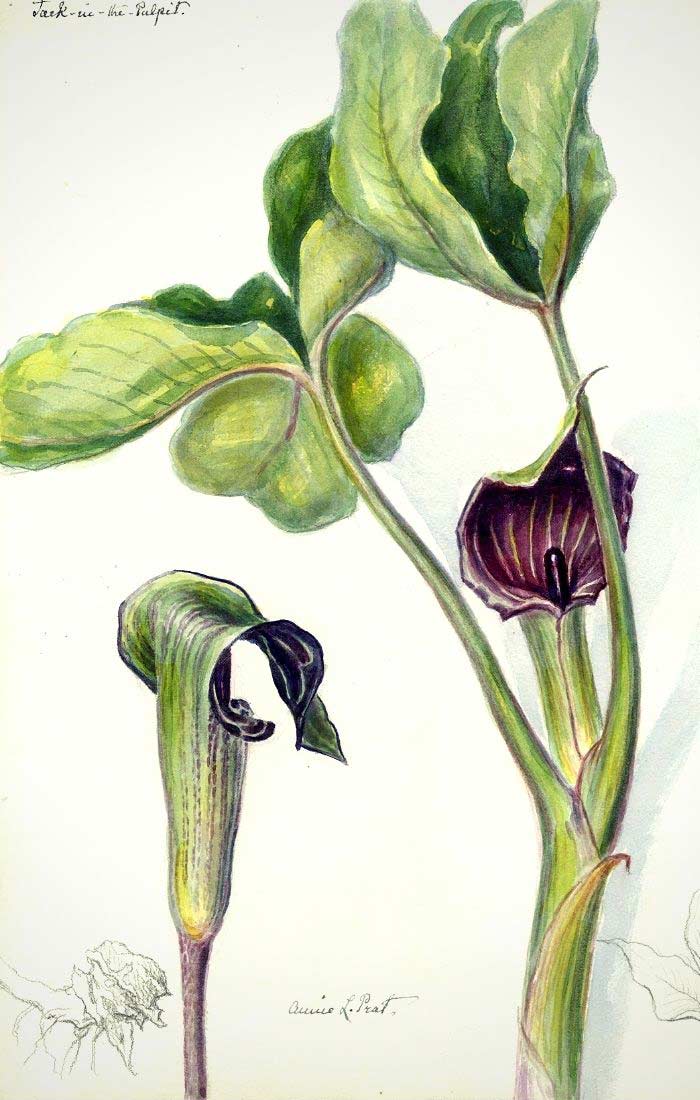
Arisaema triphyllum: Botanical illustration
Arisaema belongs to the family of Arum, the Araceae. This is a large family that includes over 3,300 species, such as Colocasia, Calla, Dracunculus, Lysichiton… Many exotic, tropical plants are found here, often with large, well-developed green leaves and very unusual flowers. This family also includes many of the most cultivated houseplants: Pothos or Scindapsus (Epipremnum aureum), Dieffenbachia, Anthurium, Monstera, Philodendron, Spathiphyllum, Zamioculcas, Zantedeschia… It also contains truly impressive plants, such as Amorphophallus titanum, which has one of the largest inflorescences in the world (up to 3.5 m tall)!
In English, Arisaema is nicknamed cobra lily: cobra lily. It owes this name to the particular shape of its inflorescences.
The size of Arisaema varies considerably depending on the species: the Arisaema candidissimum is one of the smallest, not exceeding 40 cm in height, while the largest Arisaema can reach a height of one metre (Arisaema consanguineum), or even up to 1.5 m for the Arisaema tortuosum! The thick stem that bears the flowers and leaves is often spotted, marked with purple, and also resembles the skin of a snake.
Depending on the species, Arisaema flowers in spring (in May-June for Arisaema dracontium, A. sikokianum, A. serratum…) or in summer (Arisaema candidissimum, A. consanguineum…)
Arisaema’s originality lies in its exceptional, unconventional flowering. It resembles a snake’s head… hence its nickname “cobra plant” or cobra lily! Its flowering is reminiscent of that of Arums… not surprising, since they belong to the same family! The flowers of Arisaema consist of a long, slender spadix bearing the flowers, and a spathe that surrounds it, forming a cornet. The flowering is truly characteristic of the Araceae: this organisation, with spathe and spadix, is found in Arums, Callas, Anthuriums, Spathiphyllum, Dracunculus… The spathe is tubular at the base, then opens widely to form a cornet and reveal the spadix. Then, in its upper part, the spathe widens and curves over the spadix. At the tip (apex) of the spathe, it is often extended by a very long filament. The spathe is often very decorative, usually striated. They come in shades of green, black, purple, or pink.
The spathe reveals the spadix at its centre. It is this axis that bears the flowers. A spadix can be unisexual or bisexual: it can bear either only male flowers, only female flowers, or flowers of both sexes. The female flowers are at the base, and the male flowers are above. The flowers have neither petals nor sepals, but only stamens or pistils.
Generally speaking, Arisaema adorns itself with unusual colours for flowers! Indeed, they are often green, brown, purple, or black… The Arisaema sikokianum is one of the most beautiful: it offers a stunning white-black contrast. The spadix is white and is surrounded by a very dark, almost black spathe, creating a remarkable contrast! It is a very graphic flowering. The Arisaema candidissimum stands out with its very soft pink and white hue. The Arisaema flavum, on the other hand, bears small yellow flowers!
The spathes vary in fineness, length, or curvature. Some are well opened into a cornet, while others curve forward.

The flowering of Arisaema candidissimum, A. triphyllum (photo Jason Hollinger) and A. tortuosum (photo Aniruddha Raste)
The tip of the spadix of Arisaema is often very surprising: sometimes shaped like a club (Arisaema sikokianum), other times very slender and upright towards the sky (A. tortuosum), or curling in on itself and drooping (A. speciosum)! The spadix of Arisaema tortuosum is truly surprising; it seems to defy the laws of gravity!
Arisaema also offers beautiful foliage with a very exotic style! It bears only one to two leaves, but they are large and very original. They are borne by a very long petiole (longer than the lamina). The foliage takes different forms depending on the species. The leaves are composed of at least three leaflets, sometimes more. They are very numerous and palmate in Arisaema consanguineum. The tips of its leaflets are long and pointed. The leaves can also be pedate, as in Arisaema dracontium.

The foliage of Arisaema can take different forms: Arisaema candidissimum, A. consanguineum, and A. dracontium (photos: Megan Hansen / peganum / Bob Gutowski)
The leaves are green, sometimes slightly bluish or greyish. Some Arisaema are variegated: this is the case, for example, with Arisaema consanguineum ‘Marble Leaf’.
After flowering, Arisaema with bisexual or female inflorescences produce bright red berries, which appear in late summer or early autumn. The berries are numerous and grouped in spikes on the old inflorescence. These fruits contain seeds, which can be collected to sow Arisaema. However, plants grown from seed take several years before they start to flower.
Like Arums, Arisaemas are toxic, as their tissues contain calcium oxalate crystals. However, the tuber of some species is used in traditional Chinese medicine.
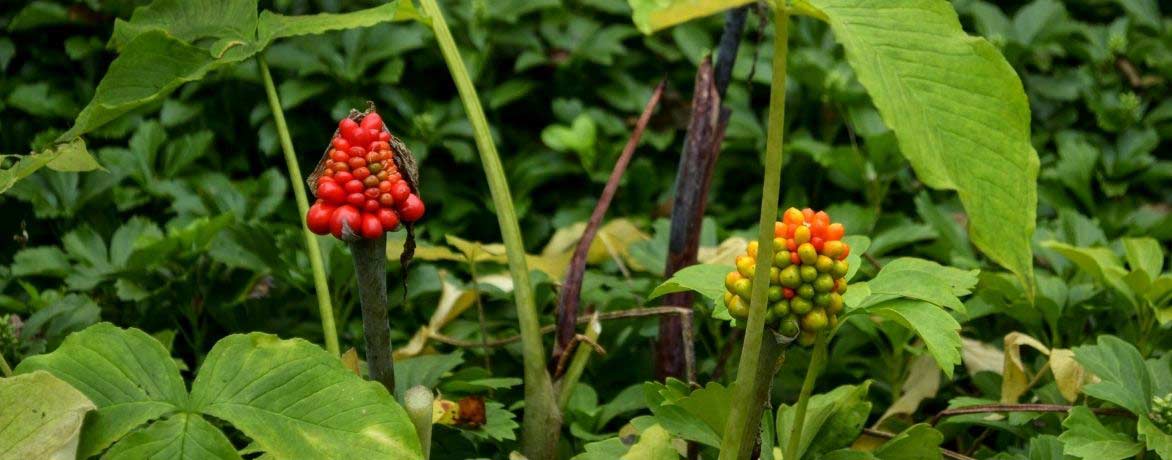
The red berries of Arisaema, which appear after flowering. Here, Arisaema triphyllum (photo: Chesapeake Conservation Landscaping Council)
“`
Read also
Planting arisaemaThe main varieties of Arisaema
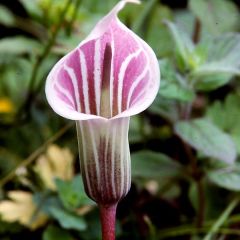
Arisaema candidissimum
- Flowering time July, August
- Height at maturity 35 cm
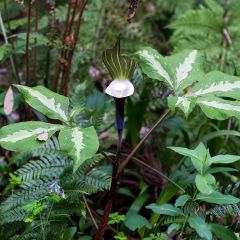
Arisaema sikokianum
- Flowering time May, June
- Height at maturity 50 cm
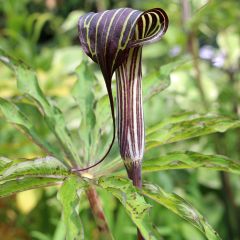
Arisaema consanguineum
- Flowering time August, September
- Height at maturity 80 cm
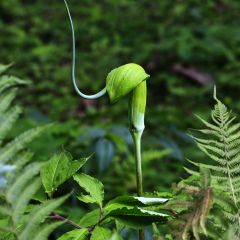
Arisaema tortuosum
- Flowering time July, August
- Height at maturity 80 cm
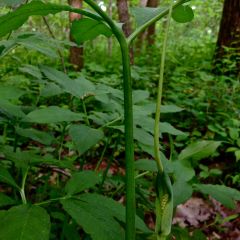
Arisaema dracontium
- Flowering time July, August
- Height at maturity 60 cm
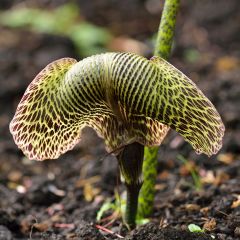
Arisaema griffithii
- Flowering time May, June
- Height at maturity 60 cm
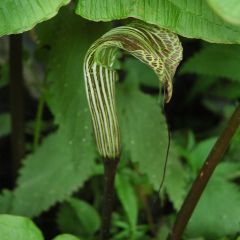
Arisaema concinnum
- Flowering time July
- Height at maturity 80 cm
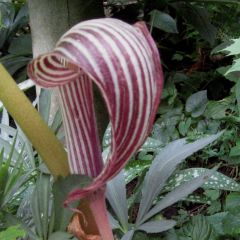
Arisaema fargesii
- Flowering time July, August
- Height at maturity 40 cm
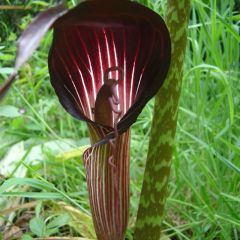
Arisaema speciosum
- Flowering time February
- Height at maturity 80 cm
Discover other Arisaemas
View all →Available in 1 sizes
Available in 1 sizes
Available in 1 sizes
Available in 1 sizes
Available in 1 sizes
Available in 1 sizes
Available in 1 sizes
Available in 1 sizes
Available in 1 sizes
Available in 1 sizes
Planting
Where to plant Arisaema?
As Arisaema is a woodland plant, it requires a shaded or partially shaded location, except for Arisaema flavum, Arisaema candidissimum, and Arisaema consanguineum, which thrive in full sun. For other species, avoid hot and sunny spots, as their foliage may get scorched and dry out.
Arisaema need a light and airy substrate! They do not like heavy, compact soils that prevent the roots from breathing and may cause the tubercles to rot. If your soil is heavy or tends to remain damp in winter, do not hesitate to plant on a small bed of gravel or coarse sand to allow for drainage. However, Arisaema still require a cool, fertile soil rich in organic matter. Feel free to mix leaf mould with your garden soil to enrich and lighten it.
In summary, the soil should remain cool in summer but must not be waterlogged in winter, as this could lead to tuber rot! It is therefore important that the soil is relatively well-draining. Excess moisture in winter, when they are in dormancy, causes the bulbs to rot!
Arisaema do not like calcareous soils. Plant them in a slightly acidic or neutral substrate. You can also plant them alongside ericaceous plants.
You can easily plant Arisaema in pots. This is a good solution if you live in a cool climate, as it will be easy to bring them indoors to protect them from frost in winter.
The key takeaway: Arisaema is sensitive to excess moisture during dormancy and to lack of water during growth.
When to plant?
You can plant Arisaema in autumn, around October, or in late winter to early spring, ideally in March or April. In any case, avoid planting during frost.
How to plant?
For planting in the ground:
- Dig a planting hole at least 30 cm wide and deep.
- Mix leaf mould into the soil to enrich it. Ideally, you can also add pine bark, coconut fibre, or gravel to achieve a light, airy, well-draining substrate.
- If your soil is heavy or tends to stay damp in winter, we recommend placing a small bed of gravel or coarse sand at the bottom, on which you will place the tubercles to prevent them from rotting.
- Plant the Arisaema tubercles. They should be buried about 20 cm deep (only 10 cm is sufficient for A. candidissimum and A. flavum). A good planting depth helps protect them from the cold in winter.
- Cover them with soil and lightly firm down.
- Water, preferably with rainwater.
If you are planting multiple young plants, maintain a distance of 20 to 30 cm between the tubercles.
Planting in pots:
- Take a large, deep pot.
- Place a drainage layer at the bottom, made of gravel or pumice, for example.
- Fill the pot with a mixture of potting soil and garden soil. The substrate should be light and airy. Ideally, you can also add pine bark, pumice, and coconut fibre.
- Then place your Arisaema tubercle in the pot. It should be buried under about 15 cm of soil. You can also place it on a small bed of gravel to prevent it from rotting.
- Cover it with substrate.
- All that’s left is to water and place the pot in partial shade.
Growing in pots will allow you to shelter your Arisaema from the cold by bringing it indoors to protect it from frost in winter.
To learn more, discover our article on planting Arisaema
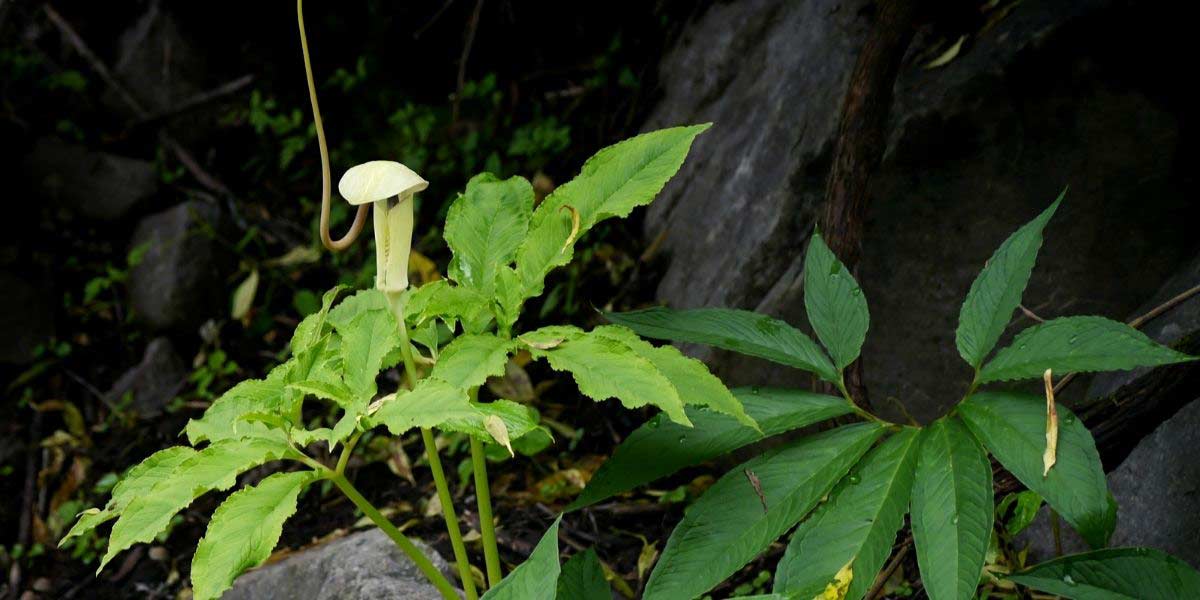
Arisaema tortuosum (photo Dinesh Valke)
Care
If you live in a cold region, do not hesitate to apply a good layer of mulch on the stump in autumn to protect it from the cold. You can use RCW (ramial chipped wood) or fallen leaves, for example. The mulch will also have the advantage of keeping the soil cool in summer. As it decomposes, the organic matter will also help enrich the soil.
We also recommend watering occasionally during dry spells to keep the soil nice and cool, especially in summer. Preferably use rainwater, as Arisaema does not appreciate lime. However, avoid excess moisture, which can rot the tubercles!
If you are growing Arisaema in a pot, it is best to repot it every year (or at least once every two years) in autumn, into a slightly larger pot. You can also take this opportunity to divide it if you notice that new small tubercles have formed around the original one. Growing Arisaema in pots also allows you to bring them indoors, dry and protected from the cold in winter. Indeed, potted plants are more exposed to the cold than those in the ground. Just water them very lightly every 15 days to prevent the tubercles from completely drying out. Wait until spring, around April, when you see the Arisaema starting to grow again, to resume regular watering.
Arisaema is not very susceptible to diseases. However, slugs may nibble on its leaves, especially when they are young. The most common problem with Arisaema is tuber rot in cases of excessive moisture.
Finally, remember to mark the location of the Arisaema, using a small stake for example, so you do not accidentally damage it while it is in dormancy and you are working in the bed.
Multiplication
Arisaema can be propagated by sowing or by dividing the tubercles. We recommend the latter technique, which is much quicker and easier than sowing.
Dividing tubercles
You can divide Arisaema every four to five years in autumn. If you are growing them in pots, take the opportunity to divide the tubercles during repotting! Dividing has the advantage of rejuvenating the clumps and giving them more space to grow.
- Choose a well-developed Arisaema that has been in place for several years.
- Carefully dig to gently remove the tubercle from the soil. Don’t hesitate to dig wide and then remove the excess soil to get a clearer view.
- You should spot new small tubercles forming around the main tubercle. Separate them gently.
- Replant the tubercles, either in pots or in the garden at a new location.
Sowing
If you wish to sow Arisaema, preferably use fresh seeds that have been recently harvested. The germination rate will be higher.
- Prepare a pot by filling it with a light substrate: for example, seed compost mixed with perlite.
- Sow the Arisaema seeds by placing them on the surface.
- Cover with a thin layer of compost.
- Water gently.
- Place your sowing under a cold frame in a bright location but out of direct sunlight.
- Arisaema seeds take a long time to germinate: you will need to wait between 3 and 6 months.
- As soon as you see the seedlings appear, reduce watering, as excess moisture could cause them to rot.
You will then need to wait at least four years before seeing them flower.
Associating
As it thrives in the shade, Arisaema easily finds its place in a woodland garden. It is an ideal plant to accompany the foliage of ferns and hostas! Enjoy the delicate flowering of Geranium nodosum, Astrantias, and Aegopodium podagraria ‘Variegata’. You can also plant them alongside ligularias, large perennials that offer decorative foliage and bright yellow flowers in summer.
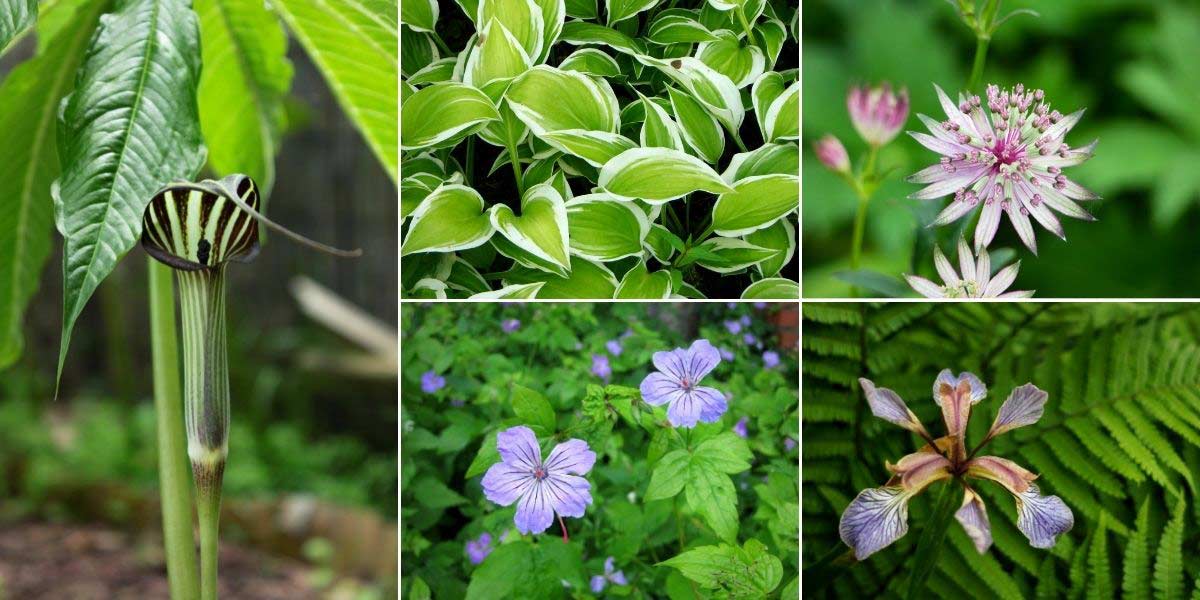
Arisaema easily finds its place in a woodland garden. Arisaema concinnum, Hosta ‘Emily Dickinson’, Astrantia major ‘Ruby Star’, Geranium nodosum, Iris foetidissima, and Dryopteris affinis
You can also place Arisaema in a cool, shaded rockery, alongside saxifrages, rock ferns (Polypodium vulgare, maidenhair, Coniogramme emeiensis…), Ajuga reptans, Tiarella, Epimediums…
For more ideas, check our advice sheet: “10 plants to create a shady rockery”
As Arisaema are plants with an exotic, tropical style, pair them with other plants that have lush foliage and unique flowers! You can combine them, for example, with Hedychiums (August-September), Colocasia, Blechnum novae-zelandiae, Tetrapanax, Fatsia japonica, Datisca cannabina… Also integrate some bamboos, and discover the surprising flowering of Cardiocrinum giganteum! You will create an original bed filled with botanical curiosities, while also providing an exotic feel!
Check out Ingrid’s article on our blog: “10 exotic and hardy plants for a jungle garden”
Useful resources
-
- Discover our entire range of Arisaema
- Our article on planting Arisaema
- Check out Michael’s article on our blog: “Arisaema ciliatum, a plant serpent”
- Another article by Michael: “Plant Rare Bulbs!”
- Gwenaëlle introduces you to green flowers and green-flowered perennials, gems of the plant world
- Subscribe!
- Contents


































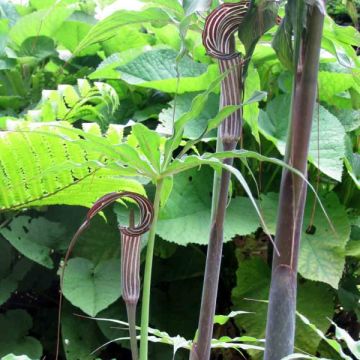




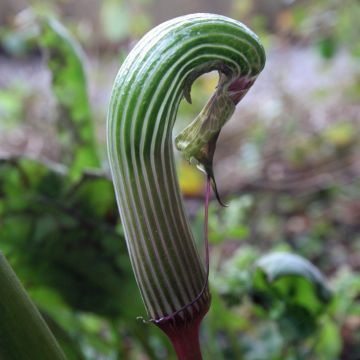

Comments